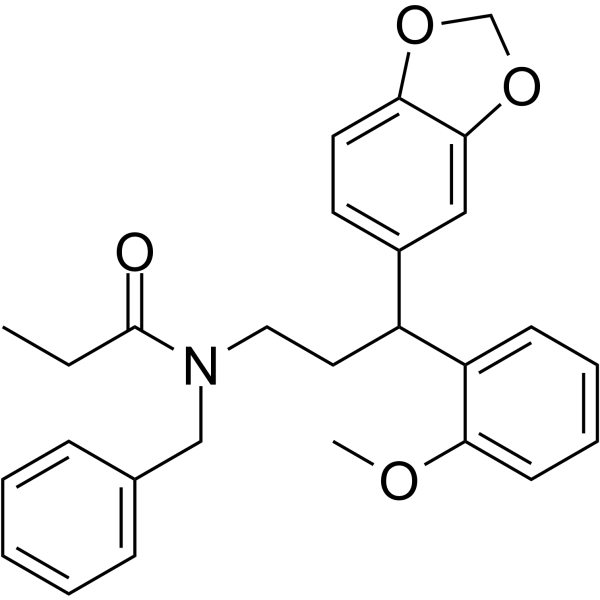
AGX51
CAS No. 330834-54-3
AGX51( —— )
Catalog No. M26050 CAS No. 330834-54-3
AGX51 is an antagonist of inhibitor of DNA binding (ID) proteins. AGX51 treatment lead to pan-Id degradation, cell cycle arrest, and cell death.
Purity : >98% (HPLC)
 COA
COA
 Datasheet
Datasheet
 HNMR
HNMR
 HPLC
HPLC
 MSDS
MSDS
 Handing Instructions
Handing Instructions
| Size | Price / USD | Stock | Quantity |
| 5MG | 262 | In Stock |


|
| 10MG | 411 | In Stock |


|
| 25MG | 653 | In Stock |


|
| 50MG | 896 | In Stock |


|
| 100MG | 1242 | In Stock |


|
| 200MG | Get Quote | In Stock |


|
| 500MG | Get Quote | In Stock |


|
| 1G | Get Quote | In Stock |


|
Biological Information
-
Product NameAGX51
-
NoteResearch use only, not for human use.
-
Brief DescriptionAGX51 is an antagonist of inhibitor of DNA binding (ID) proteins. AGX51 treatment lead to pan-Id degradation, cell cycle arrest, and cell death.
-
DescriptionAGX51 is an antagonist of inhibitor of DNA binding (ID) proteins. AGX51 treatment lead to pan-Id degradation, cell cycle arrest, and cell death.(In Vitro):AGX51 inhibits the Id1-E47 interaction. AGX51 is well-tolerated in mice and phenocopies the genetic loss of Id expression in AMD and ROP models by inhibiting retinal neovascularization. AGX51 may have utility in the management of multiple diseases.
-
In VitroWestern Blot Analysis Cell Line:4T1 cells Concentration:0, 5, 10, 20, 40 and 80 μM Incubation Time:24 hours Result:Decreased ID1 protein levels starting at a concentration of 40 μM in 4T1 cells.Western Blot Analysis Cell Line:4T1 cells Concentration:40 μM Incubation Time:0, 2, 4, 8 , 12, 24, 48 and 72 hoursResult:Decreased ID1 protein levels starting at 4 h, while until 24 h ID1 protein completely loss.Cell Viability Assay Cell Line:4T1 cells, HMLE RAS Twist, MDA-MB-157, MDA-MB-436, MDA-MB-231, MDA-MB-453, BT-474, MDA-MB-361, SK-BR-3, MCF-7, T47-D, PDX-BR7, PDX-IBT and PDX-BR11 Concentration:40 μM Incubation Time:24 hours Result:Inhibited 4T1, HMLE RAS Twist, MDA-MB-157, MDA-MB-436, SK-BR-3, MCF-7, PDX-BR7, PDX-IBT and PDX-BR11 cell lines with IC50s of 26.66, 8.7, 22.28, 30.91, 36.55, 60, 10.89, 11.97 and 18.56 μM, respectively.Cell Cycle Analysis Cell Line:4T1 cells Concentration:40 μM Incubation Time:24 and 48 hours Result:Affected cell cycle of 4T1 cells with a G0/G1 phase accumulation.Cell Viability Assay Cell Line:4T1 cells Concentration:40 μM Incubation Time:4 and 24 hours Result:Reduced phospho-histone H3 levels in 4T1 cells.Cell Viability Assay Cell Line:4T1 cells Concentration:40 μM Incubation Time:24 hours Result:Increased ROS level of 4T1 cells and indicated ROS production is a main mechanism of cell killing.
-
In VivoAnimal Model:Balb/c mice with luciferase-labeled 4T1 cellsDosage:50 mg/kg Administration:Intraperitoneal injection; 60 mg/kg twice a day; for 4 weeks Result:Inhibited lung metastasis development.Animal Model:A/J mice with AOM colon tumor model Dosage:15 mg/kg Administration:Intraperitoneal injection; 15 mg/kg twice a day; for 3 weeks Result:Dreased the colon tumors and exhibited anti-tumor activity in AOM colon tumor mice.
-
Synonyms——
-
PathwayOthers
-
TargetOther Targets
-
RecptorParasite| Sodium Channel
-
Research Area——
-
Indication——
Chemical Information
-
CAS Number330834-54-3
-
Formula Weight431.532
-
Molecular FormulaC27H29NO4
-
Purity>98% (HPLC)
-
SolubilityIn Vitro:?DMSO : 100 mg/mL (231.74 mM)
-
SMILESCCC(=O)N(CCC(c1ccc2OCOc2c1)c1ccccc1OC)Cc1ccccc1
-
Chemical Name——
Shipping & Storage Information
-
Storage(-20℃)
-
ShippingWith Ice Pack
-
Stability≥ 2 years
Reference
1.Barbara Nieradko-Iwanicka, et al. Effect of Lambda-Cyhalothrin on Memory and Movement in Mice After Transient Incomplete Cerebral Ischemia. Ann Agric Environ Med. 2011;18(1):41-5.
molnova catalog



related products
-
PCNA-I1
PCNA-I1 is an inhibitor targeting PCNA chromatin association in prostate cancer.
-
P005091
P005091 is a selective and potent inhibitor of ubiquitin-specific protease 7 (USP7) with EC50 of 4.2 μM.
-
D-Pantothenic acid
D-Pantothenic acid, also called vitamin B5, is a water-soluble vitamin and an essential nutrient for many animals.



 Cart
Cart
 sales@molnova.com
sales@molnova.com


